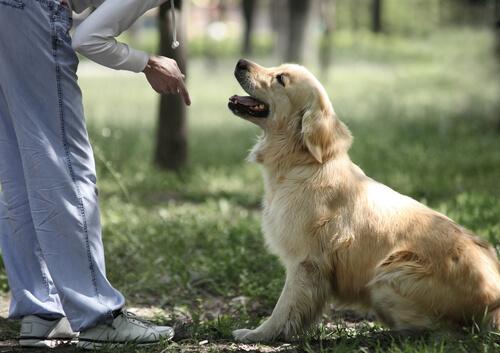10 Rules to Train Your Dog

When a dog enters your life, whether it being a puppy or a senior dog, you should know that it’s your responsibilities to train your dog. With patience, rules and lots of love, you’ll surely train your dog successfully.
Questions to keep in mind when training your pet
The first thing you should know is that it’s never too early or too late to train your pet. A puppy can begin to learn some basic rules after a few weeks of life and a senior dog is also able to assimilate new things.
Below, you can look at 10 basic rules to consider when training your furry friend.
Training your dog — with patience and lots of love — is one of the many responsibilities that you acquire when adding a dog into the family.
Patience

You’re mistaken if you think that your dog is going to learn everything all at once. Training little by little and step by step is the key to success. Show them the rules one at a time. If you get impatient you will not achieve your goals.
Consistency
Surely you’ll have to do several intents when you want to teach something your dog. So, don’t be discouraged if it’s hard for them to incorporate what you ask or make a mistake. Be consistent and determined, and you will triumph.
Clarity
In order for your dog to understand what you’re telling them, you must give clear and precise orders, using a few, short words. For example:
- Come
- Sit
- Lay
- Calm
Coherence
Don’t change the rules of the game for your furry friend because you’ll only confuse them. Always use the same terms for the same command. On the other hand, remember that what you allowed your dog today you can’t prohibit tomorrow and vice-versa. Don’t make him crazy.
Coordination
Before starting to train your pet, make sure the rest of the family agrees that everyone will use the same words for a certain command. Also, coordinate with them to make sure the dog’s rules don’t change from one person to another.
Rewards
Use positive reinforcement to educate your dog. Try to ignore what they do wrong and reward their achievements with praise, affection and, occasionally, with a treat of their liking. You will see how, little by little, you will see great progress.
Don’t punish your dog
Punishing your dog if they have trouble learning isn’t a good option. Surely dogs won’t understand why you’re angry and you’ll only get them to become a fearful and confused animal. Remember number one rule is not to lose your patience. You’ll never get anything out by being violent.
Calmly train your dog
To get good results when training your pet, it’s essential to create a relaxed atmosphere. If you transmit tension to your furry friend you’ll achieve very little. You must train your dog in a fun and entertaining environment. Playing will allow them to learn much more easily and quickly. Take it for granted.
Don’t humanize your pet
Don’t ever forget that, no matter how much you love your dog, they aren’t a human being. They’re dogs. Respect the particularities of their species and don’t expect them to be like a person because they’re dogs. Then you can train your dog without ever losing sight of this little detail.
Responsibility

Training your dog basic rules of behavior is one of the responsibilities you must assume when deciding to share your life with a canine friend. It’s something that you must commit to from the start. So really get involved with this task and ask the veterinarian for advice if you have any questions.
An extra tip to face your dog’s training
For the end, the most important thing. Start the education of your dog with a lot of love. Training your dog correctly is one more way to show your dog how much you appreciate them.
An animal that feels loved will surely learn much better and faster. And, without a doubt, they’ll know how to reward your loving dedication with much more affection.